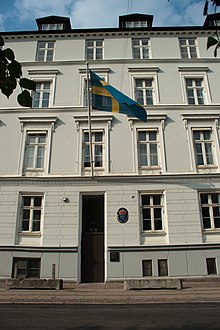Denmark–Sweden relations
This article includes a list of general references, but it lacks sufficient corresponding inline citations. (March 2020) |
 | |
Denmark |
Sweden |
|---|---|
| Envoy | |
| Ambassador of Denmark to Sweden, Kristina Miskowiak Beckvard | Ambassador of Sweden to Denmark, Charlotte Wrangberg |
The relations between Denmark and Sweden[1] span a long history of interaction. The inhabitants of each speak related North Germanic languages, which have a degree of mutual intelligibility. Both countries formed part of the Kalmar Union between 1397 and 1523, but there exists an inherited cultural competition between Sweden and Denmark. From 1448 to 1790 the two kingdoms went to war against each other at nearly every opportunity; in more than one case a new king tried to prove his worth by waging war on the other country for little or no political reason. Eleven Dano-Swedish wars took place between 1521 and 1814.
Today, the countries are separated by the
Since
Historic conflicts
Second Northern War
The Second Northern War (1655–60) was fought between Sweden and its adversaries the
In 1655,
Charles X Gustav then granted Frederick William I
Dano-Swedish War (1658–60)
The Dano-Swedish War of 1658–60 was a war between
Scanian War
The Scanian War (1675 to 1679) was a part of the
soil, in the former Danish provinces along the border with Sweden and in Northern Germany. While the latter battles are regarded a theater of the Scanian war in English, Danish and Swedish historiography, they are seen as a separate war in German historiography, called the Swedish-Brandenburgian War.The war was prompted by the Swedish involvement in the Franco-Dutch War. Sweden had allied with France against several European countries. The United Provinces, under attack by France, sought support from Denmark–Norway. After some hesitation, King Christian V started the invasion of the Scania (Skåneland) in 1675, while the Swedish were occupied with a war against Brandenburg. The invasion of Scania was combined with a simultaneous Norwegian front called the Gyldenløve Wae, forcing the defending Swedes to fight a two-front war in addition to their entanglements in the Holy Roman Empire.
Cultural links



There are extensive cultural links between Denmark and Sweden, which are often referred to as "brotherfolks" (Danish/Swedish: broderfolk ; in Swedish also brödrafolk).[citation needed] Skåneland (Blekinge, Bornholm, Halland and Scania) used to be an integral part of Denmark. At the Second Treaty of Brömsebro in 1645, Halland was transferred to Sweden for 30 years. At the Treaty of Roskilde in 1658, it was made permanent, as well as Blekinge, Bornholm and Scania becoming Swedish. However, the Treaty of Copenhagen in 1660 restored Bornholm to Denmark. The Skåneland provinces still contain many references to the Danish rule, such as in the name of many towns and cities, including Kristianstad. The construction of the Øresund Bridge has rekindled those ties, with the creation of the Øresund Region as the transnational metropolitan area comprising Copenhagen and Malmö. In addition, many Swedes and Danes consider themselves culturally and historically linked, in large part because the languages are to a large degree mutually intelligible, especially in the border regions.
Even in modern times, there have been serious talks of a
See also
- UEFA Euro 2008 qualifier fan attack
- Denmark and Sweden football rivalry
- History of Denmark
- History of Sweden
- Kalmar Union
- Swedish Gustaf's Church
References
- ^ (Danish: Forholdet mellem Danmark og Sverige; Swedish: Relationer mellan Danmark och Sverige)
- ISBN 91-89660-11-0
- ISBN 91-89080-14-9.
- ^ Frost, p. 180.


